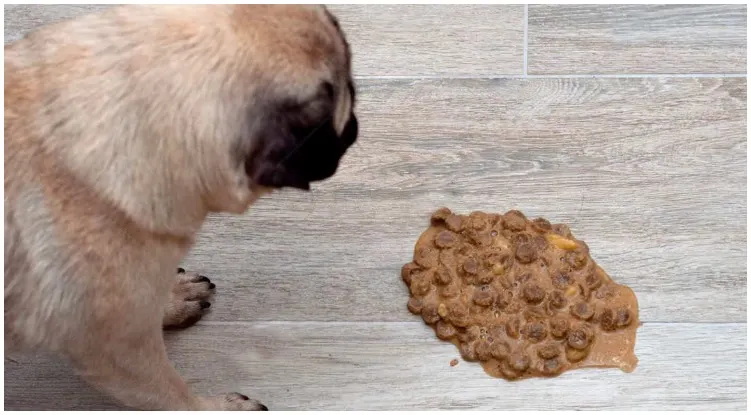Is your dog vomiting and you are unsure as to what to do? Vomiting can be caused by different triggers, in either your dog’s diet, health or the environment. Different triggers can upset your dog’s stomach and cause him to vomit in different colors or textures. We prepared a dog vomit color guide to help you differentiate between the causes.
Vomiting needs to be separated from regurgitation or coughing. Vomiting is in most cases followed by signs of nausea, abdominal pain and the presence of undigested and only partially digested food.
Different colors of your dog’s vomit can mean different things. In this article we will go over what the different colors say about your dog’s health and if you should be concerned.
A dog vomit color guide can often be the fastest way to narrow down the causes that your dog is vomiting.
Yellow Vomit
If your dog’s vomit color is yellow. In that case, what you’re seeing is known as bile.
Bile is a fluid the liver produces for digestion.
It goes from the liver to the gallbladder, where it is released into the small intestine, it can irritate the digestive system, and eventually vomit.
Yellow dog vomit is usually harmless. As long as your dog is healthy, you don’t need to be concerned.
Most Common Cause: Your dog’s stomach is empty.
What You Should Do: Feed your dog more frequently, as in split the normal portions into multiple meals However, if your dog is also lethargic, or won’t eat, take it to the vet. It could be a sign of a more serious issue.
White Vomit
White dog vomit is usually foam in the vomit. There are different reasons behind it. White foam can be an indicator for pancreatitis, bloat, kidney problems or ingestion of an inedible object. All of which cause dog owners to be more concerned.
Most Common Cause: Saliva, bloat or regurgitation
What You Should Do: Wait to see how they recover and call your vet if your dog continues to vomit on an empty stomach.
Red Vomit
Red or dark red dog vomit can be alarming to many dog owners. Since it’s often associated with blood. Causes behind vomiting blood include stomach irritation, ulcers, HGE, and other serious gastrointestinal conditions that irritate the GI tract.
Most Common Cause: Digested blood.
What You Should Do: Vomit that contains blood is a serious medical emergency that requires you to call your nearest emergency vet clinic.
Green Vomit
Green dog vomit may be due to eating grass. Grass can certainly make your dog’s vomit appear to be bright green, and will often contain pieces of plant material since grass is not easy to digest.
Most Common Cause: Bile or plant material.
What You Should Do: Wait to see how they recover and call your vet if your dog continues to vomit on an empty stomach.
Brown Vomit
Brown dog vomit can indicate a few things. The cause behind it may just be due to the color of your dog’s kibble.
A more alarming reason behind your dog’s brown vomit is due to eating feces. Eating stool, coprophagia, is quite common in our canine companions.
You can often tell if your dog is eating stool by not only the color of their vomit, but also the nasty yet familiar smell.
Most Common Cause: Intestinal blockage
What You Should Do: Call your vet if you can’t find an explanation for the brown dog vomit.
Black Vomit
Black dog vomit can be horrifying to dog owners. It can point to a serious problem in your dog such as Internal bleeding, or an abnormal growth in the dog’s stomach, or they might have ingested something poisonous.
Digested blood will often have a dark and granulated appearance, similar to the appearance of coffee grounds.
Most Common Cause: Ingestion of dirt, soil, or stony material.
What You Should Do: If your dog has pale gums, black vomit or coffee ground like material in their vomit. It’s best to call your vet as soon as possible.
Some of our other health-related articles:
- Can dogs get fevers? Signs your dog has a fever
- Dog Eye Infection Treatment
- Cross Eyed Dog: Why It Happens
- Bow Legged Dog: What You Need To Know
- How To Induce Vomiting In Dogs?

